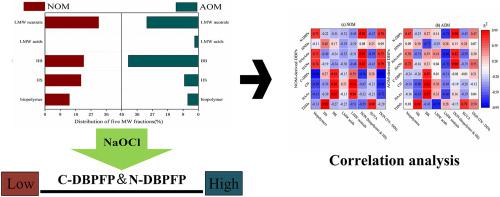Journal of Environmental Management ( IF 8.7 ) Pub Date : 2021-01-15 , DOI: 10.1016/j.jenvman.2021.111951 Xi-Xi Wang , Bao-Ming Liu , Min-Feng Lu , Yu-Ping Li , Ying-Ying Jiang , Ming-Xing Zhao , Zhen-Xing Huang , Yang Pan , Heng-Feng Miao , Wen-Quan Ruan

|
Algal organic matter (AOM) and natural organic matter (NOM) from a typical eutrophic lake were comprehensively investigated in terms of their physico-chemical property, components and disinfection byproduct formation potentials (DBPFPs). The relationships between specific chemical properties of AOM and NOM with their corresponding DBPFPs were further evaluated during chlorination. Results indicated that AOM had lower specific UV absorbance (SUVA) but richer organic nitrogen contents than NOM. Fluorescence excitation emission matrix spectroscopy further demonstrated that AOM were chiefly composed of aromatic protein-like and soluble microbial byproduct-like matters, while NOM were mainly contributed from humic acid-like and soluble microbial byproduct-like substances. Although the molecular weight (MW) distribution of AOM and NOM showed no significant difference, size-exclusion chromatography with organic carbon as well as organic nitrogen detection (LC-OCD-OND) revealed that AOM were concentrated with the fraction of building blocks and NOM had higher concentrations of biopolymers and humics (HS). Moreover, AOM displayed higher DBPFPs than NOM, especially for nitrogenous DBPFP (N-DBPFP). MW < 1 kDa fractions both in AOM and NOM contributed the largest proportion to the formation of carbonaceous disinfection byproducts (C-DBPs). In addition, Pearson correlation analysis showed that bulk parameter SUVA was significantly relevant to the formation potentials of trihalomethane both in AOM and NOM, but was ineffective for carbonaceous DBPFP (C-DBPFP) prediction. Dissolved organic nitrogen contents in biopolymer and HS characterized by LC-OCD-OND had strong correlations with N-DBPFPs from AOM and NOM, indicating that LC-OCD-OND quantitative analysis could improve the prediction accuracy of the DBP formation than bulk parameters during NOM and AOM chlorination.
中文翻译:

藻类有机物作为碳和氮消毒副产物形成的前体的表征:与天然有机物的比较
对来自典型富营养化湖泊的藻类有机物(AOM)和天然有机物(NOM)的理化性质,组分和消毒副产物形成潜能(DBPFP)进行了全面研究。在氯化过程中,进一步评估了AOM和NOM的特定化学性质与其对应的DBPFP之间的关系。结果表明,AOM比NOM具有较低的紫外线吸收率(SUVA),但有机氮含量较高。荧光激发发射矩阵光谱进一步证明,AOM主要由类芳香蛋白和可溶性微生物副产物样物质组成,而NOM主要由腐殖酸样和可溶性微生物副产物样物质组成。尽管AOM和NOM的分子量(MW)分布没有显着差异,但使用有机碳的尺寸排阻色谱法以及有机氮检测(LC-OCD-OND)表明,AOM集中了部分结构单元和NOM含有更高浓度的生物聚合物和腐殖质(HS)。此外,AOM显示的DBPFP高于NOM,尤其是含氮DBPFP(N-DBPFP)。AOM和NOM中的MW <1 kDa馏分均对碳质消毒副产物(C-DBPs)的形成贡献最大。此外,Pearson相关分析显示,体量参数SUVA与AOM和NOM中三卤甲烷的形成潜力均显着相关,但对碳质DBPFP(C-DBPFP)预测无效。



























 京公网安备 11010802027423号
京公网安备 11010802027423号